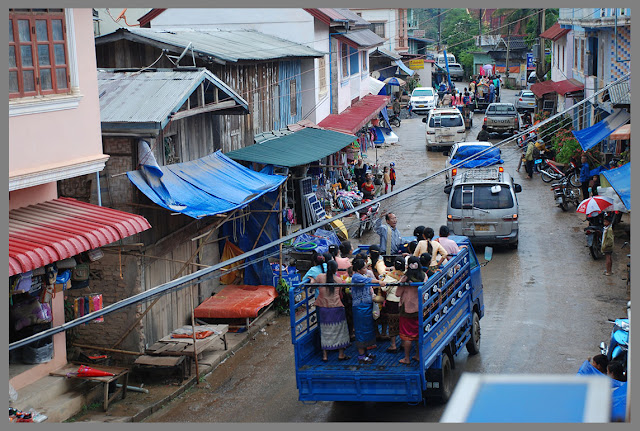Entrance by land, via
Tay Trang / Pang Hok ( Sa Pa ‑ Muang Khua )
JOURNEY :
Sa Pa and Muang Khua are about 200 km away in a straight line, equivalent to about 400 km of roads and about 15 hours of travel (as long as there are no problems).
To do this, it is necessary to change bus in Dien Bien Phu, a small city a just before reaching the border. From here, very early in the morning, is where the minibus to Muang Khua departs.
To get to Dien Bien Phu, there are basically two combinations to go: either in a minibus that leaves in the morning from Sa Pa, and arrives in the evening at Dien Bien Phu, or take a night bus with bunk beds that departs at night from Sa Pa, reaching Dien Bien Phu just in time to take the minibus Direction Laos.
We opted for the option of the night bus for several reasons: We had heard from other travelers that the minibus, which is not particularly big, could get overcrowded with more passengers than seats. On the other hand, if we took the night bus, we could save one night. In addition, the price of one option or the other, was not very different.
This route is not very frequented by tourists, therefore there is no excessive information. So, you have to look very well with whom the service is contracted. Not only because of the difference in prices (for exactly the same service), but also because of the guarantees of trust they give you.
After asking and comparing many places, we decided to buy it through our accommodation, the Sapa Backpacker Hostel, which made us a very good price, 430.000 Dong (about 20€) per person, and they guaranteed us all connections from the hotel door until our final destination, as well as, that the bus from ;Dien Bien Phu to Muang Khua would not leave until we arrived.
The journey was as agreed. The taxi from the hotel to the "bus station" of Sa Pa was also included in the ticket price. In addition, the receptionist of the hostel followed us on a motorbike to make sure everything went correctly. She also was in telephone contact with the bus driver to make sure that they would pick us up, which was very much appreciated, because otherwise, we would have been quite afraid, because it didn't look like a Bus would ever come to this place they call "bus station".
The bus was old and did not smell very good, we imagined it even worse, so for us it was ok. Before it became dark outside, we could enjoy the breathtaking views of the mountains (and the cliffs!) that surrounded us We arrived at Dien Bien Phu just before sunrise. The bus stopped on the outskirts of the town, next to a small roadside bar, in the middle of the nowhere. There, they tried to explain us that we should not worry about anything, although that, we were a bit worried. But after a while, a car arrived, which took us to the bus station and told us which was the minibus we had to take. As we arrived relatively early, we even were able to get a decent seat.

MONEY :
Another very important issue when crossing from Vietnam to Laos is the money. Neither the Vietnam Dong, nor the Laos Kip are traded on the international markets. It is for this reason that it is practically impossible to exchange these currencies outside of their respective countries.
Although, it is true that it is possible to exchange Dongs for Kips in border towns, such as Dien Bien Phu, this did not help us much, since our minibus left very early in the morning, we already knew, that there would be no exchange house open at that time, so we would have had to change the money in the street, at a very unfavorable exchange rate of course. For this reason, we decided to change most of our dongs for dollars in Sa Pa, and keep just some little money, that we would change at the street in Dien Bien Phu.
BORDER AND VISA :
The border crossing at
Tay Trang / Pang Hok is located in the middle of the mountains, on a route without much traffic, therefore, there is practically no queuing at the border and everything is very relaxed.
To enter Laos it is necessary to have a visa, which can be purchased directly at the border as a Visa on arrival. Its official price is 35 US dollar. As always, it is convenient to have the exact amount in this currency.
The entrance border to Laos, is a little house, with several windows. Here you must hand in your passport, as well as the completed form they give you and a photo. Then they issue you the visa and you pay the official 35 dollar for the visa, plus some extra "tax".
Once these procedures were completed, the road went down to Muang Khua, where our minibus dropped us of on the main road, just at the center of this small town.

























































